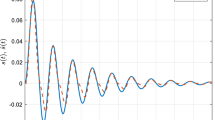Abstract
The main objective of this paper is to present an alternative method for computing the membership function of the system under intuitionistic fuzzy set environment. Conventionally, it is not always easy to obtain the system reliability for components with different individual failure probability density function due to necessary but complicated combination and integration of various probability density functions. Also, in the literature, it is assumed that failure rates of all the components of a system follow the same type of fuzzy set which is rarely occurring in the practical situations. Thus, this paper addresses the fuzzy system reliability analysis to construct the membership and non-membership functions by considering the different types of intuitionistic fuzzy failure rates. Functions of intuitionistic fuzzy numbers are calculated using credibility theory. The effectiveness of the proposed approach is illustrated with analyze of the fuzzy reliability of series, parallel and series-parallel systems using different types of intuitionistic fuzzy failure rates. The computed results from the analysis have a less range of uncertainty as the comparability of existing results.




Similar content being viewed by others
References
Attanassov KT (1986) Intuitionistic fuzzy sets. Fuzzy Sets Syst 20:87–96
Biswas R (1997) On fuzzy sets and intuitionistic fuzzy sets. Notes on Intuitionistic Fuzzy Sets 3:3–11
Bustince H, Burillo P (1996) Vague sets are intuitionistic fuzzy sets. Fuzzy Sets Syst 79(3):403–405
Cai KY (1996) System failure engineering and fuzzy methodology: an introductory overview. Fuzzy Sets Syst 83:113–133
Chang JR, Chang KH, Liao SH, Cheng CH (2006) The reliability of general vague fault tree analysis on weapon systems fault diagnosis. Soft Comput 10:531–542
Chen SM (1995) Arithmatic operations between vague sets. In: Proceeding of the International Joint conference of CFSA/IFIS/SOFT’95 on fuzzy theory and applications, Taipei, pp 206–211
Chen SM (2003) Analyzing fuzzy system reliability using vague set theory. Int J Appl Sci Eng 1(1):82–88
Donighi SS, Khanmohammadi S (2011) A fuzzy reliability model for series—parallel systems. J Ind Eng Int 7(12):10–18
Duque O, Morifiigo D (2004) A fuzzy Markov model including optimization techniques to reduce uncertainty. In: IEEE Melecon 2004, vol. 3, pp 841–844
Durga-Rao K, Kushwaha HS, Verma AK, Srividya A (2008) Epistemic uncertainty propagation in reliability assessment of complex systems. Int J Perform Eng 4(1):71–84
Garg H (2013) Reliability analysis of repairable systems using Petri nets and Vague Lambda-Tau methodology. ISA Trans 52(1):6–18
Garg H, Rani M (2013) An approach for reliability analysis of industrial systems using PSO and IFS technique. ISA Trans 52(6):701–710
Garg H, Rani M, Sharma SP (2013) Reliability analysis of the engineering systems using intuitionistic fuzzy set theory. J Qual Reliab Eng 10 (Article ID 943,972)
Garg H, Rani M, Sharma SP (2014) An approach for analyzing the reliability of industrial systems using soft computing based technique. Expert Syst Appl 41(2):489–501
Garg H, Sharma SP (2012) Stochastic behavior analysis of industrial systems utilizing uncertain data. ISA Trans 51(6):752–762
Gau WL, Buehrer DJ (1993) Vague sets. IEEE Trans Syst Man Cybern 23:610–613
Kaufmann A, Gupta MM (1985) Introduction to fuzzy arithmetic: theory and applications. Van Nostrand, New York
Kumar M, Yadav SP (2011) Fuzzy system reliability analysis using different types of intuitionistic fuzzy numbers. In: 11th International Conference on Hybrid Intelligent Systems (HIS), pp 247–252. doi:10.1109/HIS.2011.6122113
Kumar M, Yadav SP (2011) A new approach for analysing the fuzzy system reliability using intuitionistic fuzzy number. Int J Ind Syst Eng 8(2):135–156 (2011)
Kumar M, Yadav SP (2012) A novel approach for analyzing fuzzy system reliability using different types of intuitionistic fuzzy failure rates of components. ISA Trans 51(2):288–297. doi:10.1016/j.isatra.2011.10.002
Kumar P, Aggarwal KK (1993) Petri net modeling and reliability evaluation of distributed processing systems. Reliab Eng Syst Saf 41(2):167–176
Lin YK (2004) Uncertainty theory: an introduction to its axiomatic foundations. Springer, Berlin
Liu B (2002) Theory and practice of uncertain programming. Physica-Verlag, Heidelberg
Liu B, Liu YK (2002) Expected value of fuzzy variable and fuzzy expected value model. IEEE Trans Fuzzy Syst 10(4):445–450
Mahapatra GS, Mitra M, Roy TK (2010) Intuitionistic fuzzy multi-objective mathematical programming on reliability optimization model. Int J Fuzzy Syst 12(3):259–266
Mon DL, Cheng CH (1994) Fuzzy system reliability analysis for components with different membership functions. Fuzzy Sets Syst 64(2):145–157
Ross TJ (2004) Fuzzy logic with engineering applications, 2nd edn. Wiley, New York
Shu MH, Cheng CH, Chang JR (2006) Using intuitionistic fuzzy sets for fault-tree analysis on printed circuit board assembly. Microelectron Reliab 46:2139–2148
Singer D (1990) A fuzzy set approach to fault tree and reliability analysis. Fuzzy Sets Syst 34(2):145–155
Utkin LV, Gurov SV (1996) A general formal approach for fuzzy reliability analysis in the possibility context. Fuzzy Sets Syst 83:203–213
Verma AK, Srividya A, Gaonkar RSP (2007) Fuzzy reliability engineering: concepts and applications. Narosa Publishing House Pvt. Ltd., New Delhi
Zadeh LA (1965) Fuzzy sets. Inform Control 8:338–353
Zio E (2009) Reliability engineering: old problems and new challenges. Reliab Eng Syst Saf 94(2):125–141
Zio E, Baraldi P, Librizzi M, Podofillini L, Dang VN (2009) A fuzzy set-based approach for modeling dependence among human errors. Fuzzy Sets Syst 160(13):1947–1964
Author information
Authors and Affiliations
Corresponding author
Additional information
Technical Editor: Marcelo A. Trindade.
Rights and permissions
About this article
Cite this article
Garg, H. A novel approach for analyzing the reliability of series-parallel system using credibility theory and different types of intuitionistic fuzzy numbers. J Braz. Soc. Mech. Sci. Eng. 38, 1021–1035 (2016). https://doi.org/10.1007/s40430-014-0284-2
Received:
Accepted:
Published:
Issue Date:
DOI: https://doi.org/10.1007/s40430-014-0284-2




